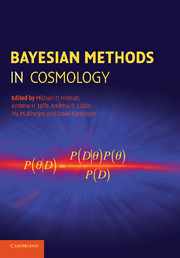Book contents
- Frontmatter
- Contents
- List of contributors
- Preface
- Part I Methods
- 1 Foundations and algorithms
- 2 Simple applications of Bayesian methods
- 3 Parameter estimation using Monte Carlo sampling
- 4 Model selection and multi-model inference
- 5 Bayesian experimental design and model selection forecasting
- 6 Signal separation in cosmology
- Part II Applications
- Index
2 - Simple applications of Bayesian methods
Published online by Cambridge University Press: 11 April 2011
- Frontmatter
- Contents
- List of contributors
- Preface
- Part I Methods
- 1 Foundations and algorithms
- 2 Simple applications of Bayesian methods
- 3 Parameter estimation using Monte Carlo sampling
- 4 Model selection and multi-model inference
- 5 Bayesian experimental design and model selection forecasting
- 6 Signal separation in cosmology
- Part II Applications
- Index
Summary
Having seen how the need for rational inference leads to the Bayesian approach for data analysis, we illustrate its use with a couple of simplified cosmological examples. While real problems require analytical approximations or Monte Carlo computation for the sums to be evaluated, toy ones can be made simple enough to be done with brute force. The latter are helpful for learning the basic principles of Bayesian analysis, which can otherwise become confused with the details of the practical algorithm used to implement them.
Introduction
In science, as in everyday life, we are constantly faced with the task of having to draw inferences from incomplete and imperfect information. Laplace (1812, 1814), perhaps more than anybody, developed probability theory as a tool for reasoning quantitatively in such situations where arguments cannot be made with certainty; in his view, it was ‘nothing but common sense reduced to calculation’. Although this approach to probability theory lost favour soon after his death, giving way to a frequency interpretation and the related birth of statistics (Jaynes 2003), it has experienced a renaissance since the late twentieth century. This has been driven, in practical terms, by the rapid evolution of computer hardware and the advent of larger-scale problems. Theoretical progress has also been made with the discovery of new rationales (Skilling 2010), but most scientists are drawn to Laplace's viewpoint instinctively.
In the past few years, several introductory texts have become available on the Bayesian (or Laplacian) approach to data analysis written from the perspective of the physical sciences (Sivia 1996; MacKay 2003; Gregory 2005).
- Type
- Chapter
- Information
- Bayesian Methods in Cosmology , pp. 36 - 56Publisher: Cambridge University PressPrint publication year: 2009



